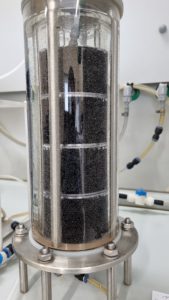In response to the growing challenges of industrial wastewater treatment, particularly in the textile industry, a research team has designed an innovative semi-periodic bubble column optimized for hydrodynamics to remove contaminants through catalytic ozonating using thin-film catalysts more effectively.
The textile industry is known for producing a large volume of wastewater contaminated with dyes, chemicals, and other harmful substances. Traditional treatment methods often struggle to remove these contaminants in an efficient and sustainable manner. The new bubble column, designed by the research team, uses catalytic ozonation to reduce contamination in textile wastewater and enable its closed-loop recycling within the industrial facility.
The primary goal in designing the column was to optimize hydrodynamic parameters to ensure maximum dispersion of ozone and even contact with the wastewater. This was achieved through a special column structure with a framework allowing for controlled ozone flow and effective mixing. The use of a catalyst further enhances the efficiency of the ozonation reaction, leading to higher removal efficiency of contaminants.
The research team plans to conduct further studies to examine how the bubble column performs under industrial conditions (scaled up by 10 times). If the tests are successful, this technology could become a key tool in combating water pollution and recycling, contributing to a more sustainable future.

Bubble column with baffles
